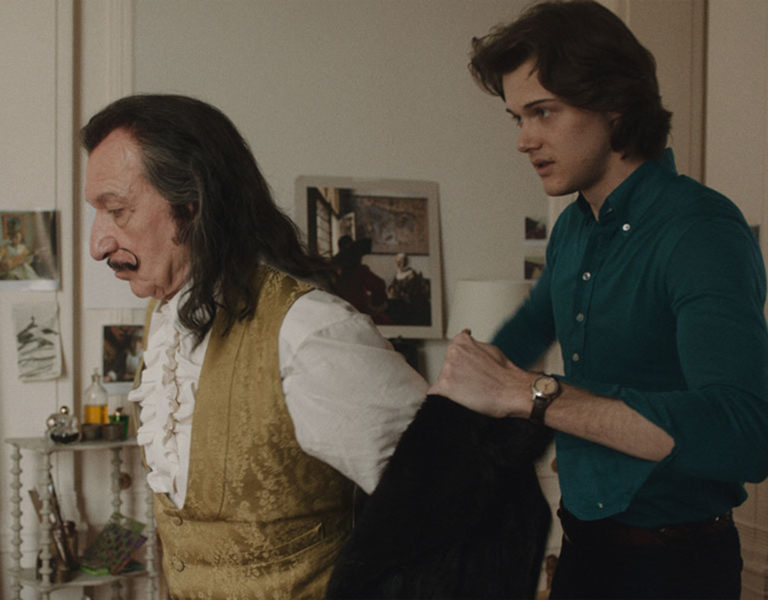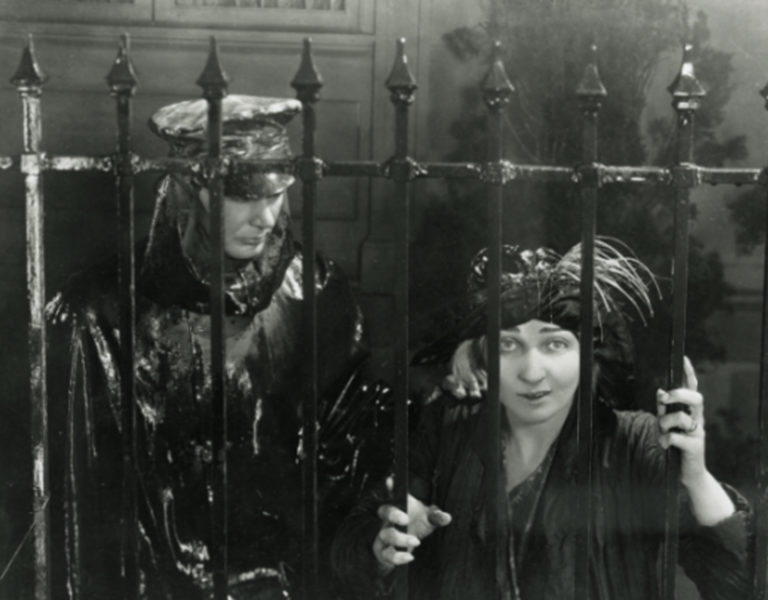Fright night
Cinematographer Brett Jutkiewicz is tasked with bringing Ghostface to New York City in slasher favourite Scream‘s latest outing.
After a decade-long hiatus, slasher fans were in for a thrill with the announcement of a fifth instalment of the Scream franchise, released in 2022. Breathing down its neck comes Scream VI, lensed (like its predecessor) by American cinematographer Brett Jutkiewicz (Stranger Things S4, Ready or Not) in his third collaboration with filmmaking team Radio Silence. He reflects on his experience lensing the franchise’s sixth chapter, including making the move from anamorphic to spherical, working with co-directors, and the pleasures of crafting a horror film’s distinct visual language as a DP.

Can you introduce yourself and tell us about your career journey so far?
As a teenager, I developed a passion for 35mm black and white still photography and would often commandeer my family’s camcorder to make skateboarding videos and short films that I would edit myself using two VHS tape decks. I was always drawn to being behind the camera and making movies, but it wasn’t until I befriended some film students at university that I realised cinematography was actually something I could pursue as a career. After graduating from Boston University with a film degree, I moved to New York City and photographed my first feature a year later – an indie film on super 16mm film with a crew of about four people called The Pleasure of Being Robbed, directed by my university classmate Josh Safdie. That film found success in festivals, and I spent the next several years shooting independent films, commercials, music videos, and documentaries – really anything I could get my hands on. Those projects and the relationships I made gradually led to working on larger-scale projects until I met Scream VI directors Tyler Gillett and Matt Bettinelli-Olpin when they hired me to shoot Ready or Not in 2017. Scream VI is my third collaboration with Tyler, Matt, and their producing partner Chad Villella who make up the collective Radio Silence.
You’re making a real name yourself lensing horrors – what is it about the genre that appeals to you as a DP?
Shooting horror films was not something I had anticipated, although I’m very grateful I’ve had these opportunities. I hadn’t shot a true horror film when Tyler and Matt hired me for Ready or Not, so credit to them for trusting that I could help bring their vision to life in a genre that was somewhat new to me. What appeals to me about horror is that broadly speaking, I think the genre lends itself to taking more risks in creating a distinct visual language. The cinematography is about supporting the story and the performance as much as in any other film, but with the added elements of creating an immersive, tense, scary experience for the audience, so I can really be creative with that approach through the lighting and the camerawork.
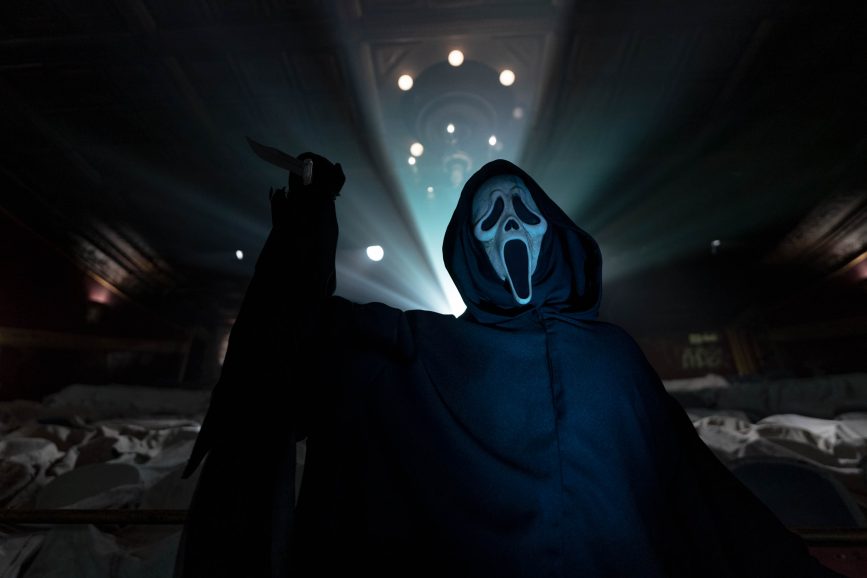
How did you join the revamped Scream franchise and what specifically appealed to you about the premise for Scream VI?
After Ready or Not, Tyler and Matt asked me to shoot Scream (2022). First and foremost, I was excited to collaborate with them again but also excited about the opportunity to be a part of such a storied franchise. The first thing that struck me reading the script for Scream VI was the location – New York City. I knew it was a first for the franchise, and being a New Yorker myself, I was excited about the possibilities of bringing Ghostface to the city. Now the threat was not coming from outside a quiet suburban home but could be creeping around any street corner, or in any crowd, at any time.
Were there any particular advantages or challenges about working with co-directors on a feature as a cinematographer?
I’ve done a few films with co-directors, and each experience is different, but in the case of Scream VI and all of my work with Matt and Tyler, there were only advantages. They are very much of the ethos that the best idea wins – there is really no ego or preciousness about anything. There are certainly discussions about what that best idea is, but a lot of that we are able to work out in prep so that when we are shooting, things flow very seamlessly. On set, a very practical advantage is that Tyler can work with me on adjusting a camera move while Matt talks to the actors at the same time, so that helps us move a little more quickly, though they are both involved in every aspect of directing. They have such a collaborative spirit, and often our discussions lead to much better ideas than any of us started with individually. That spirit also extends to everyone in the cast and crew, and it creates a wonderful work environment for everyone.

Tell us about your initial conversations with Matt and Tyler about the look and mood for Scream VI. What was their vision and what new perspectives did you bring to discussions?
A lot of our initial discussions hinged on two new elements that this film brought to the franchise: the location of New York City and this film’s Ghostface, who is a bit more ruthless and brazen than the Ghostfaces that have come before. We were on the same page with our initial perspectives on the film – we wanted to embrace a slightly more dark, gritty, and visceral feel, which felt connected to both of these new elements. We wanted the city to feel like there could be danger around any corner or in any crowd. I also liked the idea of introducing a sense of claustrophobia to the city – living in New York, we spend so much time in these tight spaces – whether it’s a subway car or a small apartment or a corner store, it’s a big city, but the day-to-day of it is often very small, and that makes Ghostface such a menacing present in these small spaces where there is often only one escape route. I pulled some imagery for mood, tone, and colour references, but because this was our third film together and we have such a strong sense of each other’s sensibilities, we didn’t need to do as much reference sharing.
How much did you want to pay homage to the older films in the franchise in your lensing, if at all?
In Scream (2022), we continued the franchise’s tradition of shooting anamorphic, although it was the first of the series to be shot digitally. We talked about that film like the passing of the baton, and we wanted to put our own creative stamp on it and make sure it connected to the aesthetic of the series as a whole. On Scream VI, we thought we could push that a bit further, and early on, I pitched Matt and Tyler on switching to spherical lenses. As cinematographers, we love anamorphic lenses for their unique and often impressionistic characteristics. And for this film, I wanted to strip away that extra layer of artifice that anamorphic lenses create, that subtle additional cue that you are watching a movie, because it would ground the visuals in the characters’ experience and put the audience in that perspective. For me, spherical lenses have a bit more immediacy to being closer to how the eye sees, so I thought that would be a good fit for the feeling we were after. I think personally, having spent the first part of my career running around the streets of New York shooting 16mm film on spherical lenses, it had a particular connection for me as well.
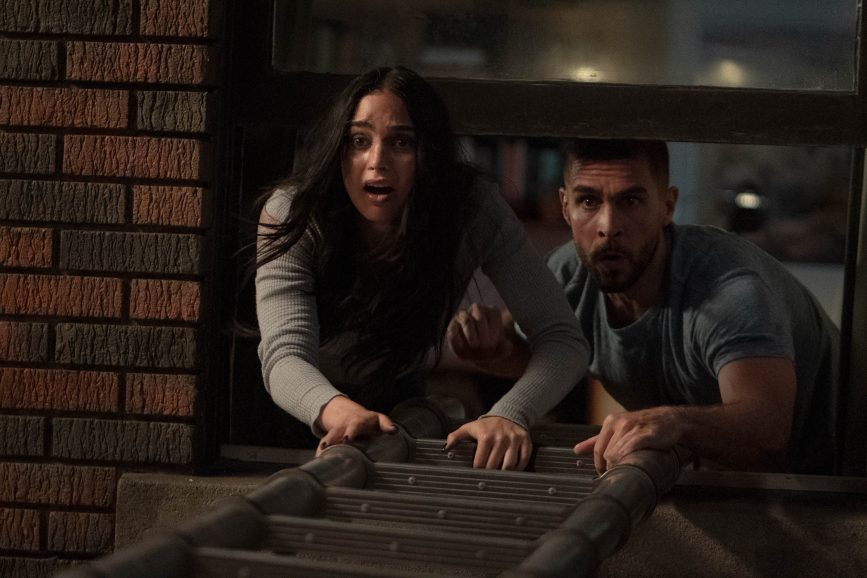
Take us through prep for the film…
We had a week of recce in March 2022 to take an advance look at some locations, and prep was six weeks in April and May. We were fortunate to have a good idea of our locations by the time we started prep, so while we did have to look for some locations, it wasn’t as exhaustive as it normally is, which gave us more time to focus on some of the very complex sequences we were dealing with. A large part of my prep with the directors was attributed to shot listing, which I find to be an incredibly valuable process that allows me to walk through the film beat by beat and invariably leads to important creative and logistical conversations. A lot of what we did in our sessions was discussing the blocking of scenes – with so many scenes that included five, six, seven, or more characters, and it was crucial for us to determine the broad strokes of the blocking in prep. With that many characters in a scene, there are just too many variables to debate on the shoot day, so we had digital floor plans of our locations provided by the art department, and we would draw the character and camera positions on an iPad. We were, of course, able to adjust to input from the actors on the day, but having the starting point was invaluable – and helped every aspect, from scheduling to discussions with the art department about set builds and furniture placement.
Can you run us through the key filming locations?
I was fortunate to be involved in the directors’ recce prior to my official prep start. It’s important for me to be as involved as possible in choosing locations, as they are consequential decisions often made very early in the prep process – usually before I’ve even had a chance to have in-depth discussions with the directors about the script. In this case, it was the roughly two-thirds location and one-third stage work – with our main set builds being Sam’s (Melissa Barrera) and Tara’s (Jenna Ortega) apartment, which included part of the exterior of the building as well as Danny’s (Josh Segarra) apartment, and the subway car and platform set. Our key location work was the Ghostface shrine at the abandoned movie theater, which was a practical location in Montreal’s Gay Village, as well as the bodega, Gale’s (Courteney Cox) apartment, and the full exterior of Sam and Tara’s building which the art department matched on stage for our sets.
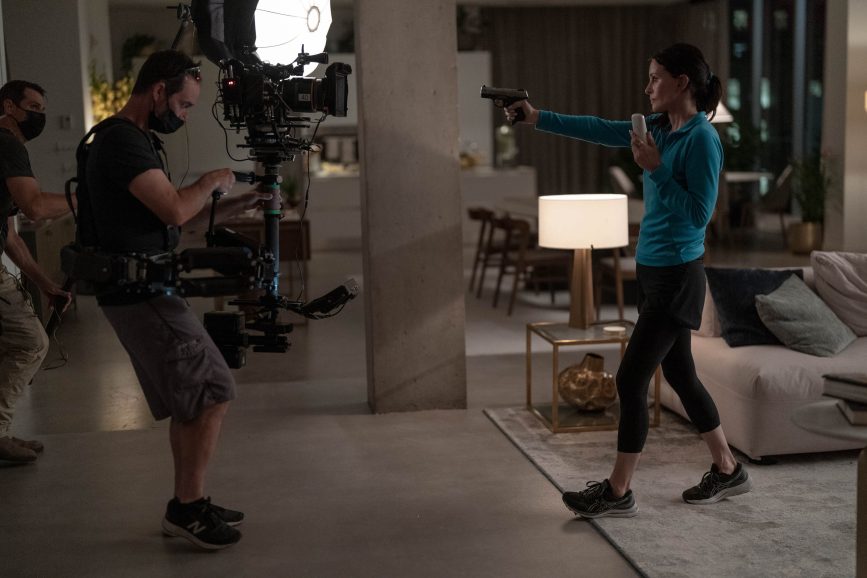
Which location posed the biggest cinematographic challenge?
Shooting in Gale’s apartment was quite challenging since it was a real apartment on the top floor of a high-rise building. We were very restricted in terms of what we could rig in the space, but I managed to find places to hide Astera tubes to give me some ambiance to add to what the practicals were doing. Because of our schedule, parts of each scene had to be filmed day-for-night, so we blacked out the space and shot tighter angles to avoid seeing too many windows during the day, then would pull the blacks up and shoot our wider shots during the real night. It took a lot of planning and coordinating to get it all done in our three days there, and on our last night, the sun started coming up, and we had to pull all of our blacks back down to finish shooting the scene into the morning. It was probably the most stressful day of the shoot, but credit to my crew for never wavering and our cast, especially Courteney Cox, for helping us get through those long nights.
When did principal photography begin and how long did it last?
Principal photography began on 9 June 2022, and lasted 52 shooting days.
Tell us about your camera package. Which camera and lenses did you choose and why?
We shot on the Arri Alexa Mini and Cooke S5i lenses supplied by MELS Studios in Montreal. I love the Alexa for its color rendition and filmic texture, and the Mini was great for all of our steadicam and handheld work. I tested a few different sets of spherical primes, and I set up a blind screening for the directors without indicating to them which specific sets they were looking at. We all independently agreed that the Cookes had the right look, which coincidentally were the same lenses we used on Ready or Not. I love that the S5i lenses are modern and clean without being overly sharp or clinical – they have a beautiful roundness to them, and in the way, the focus falls off. For the most part, I shot them clean without any added diffusion but occasionally added an ⅛ Hollywood Black Magic for closeups.
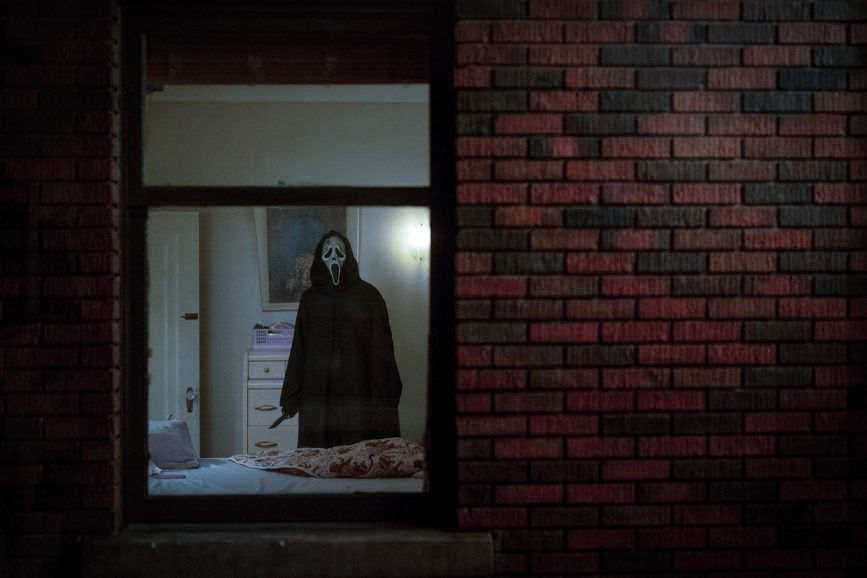
Tell us about your approach to camera movement in building tension in Scream VI.
I built the camerawork around tension and release, creating anticipation and leaning into the action sequences’ visceral nature. With Ghostface, I often used handheld camerawork to ground the audience in the characters’ experience and heighten the intensity of those moments. It was also important for me to be able to react to Ghostface – we had such a great stunt performer behind the mask who was very physical and imposing, and the looseness of the camera in those sequences really allowed my operators to take cues from him on the fly and capture that performance. To contrast that, I used dolly and steadicam moves to create a subtle unease throughout the film. The camera is never completely static in the film; there is always a slow movement or drift to create a feeling of anticipation. I used more sweeping technocrane movement in a few key moments, like the ladder sequence between apartments when Sam looks out the window to the alley below. The camera pulls out wide overhead in a visual manifestation of the fear she is experiencing at that moment.
Were there any new tricks, techniques or interesting kit you used for the first time in your lensing Scream VI?
This was my first time working extensively with the Creamsource Vortex LED lights. I use a lot of Skypanel S60 and S360s, but found that the Vortex was about the size of the S60 with an output closer to the S360. We used them in the abandoned theatre programmed to simulate the flicker of the projection, used them in lifts on our night exteriors as streetlights, and they made a great soft key light inside a 5-foot octagonal softbox.

What was your general approach to lighting, especially for creating tension and atmosphere?
My gaffer Eames Gagnon and his team, along with key grip David Dinel and his team, did an amazing job to help bring these sequences to life. In general, I would describe the style of lighting as a heightened naturalism – lighting that feels real and true to the spaces but also adds to the scene’s emotional impact. An example in the shrine are the spotlights illuminating the Ghostface robes on stage, which are not realistic in the sense of how the characters who created that space in the film could have lit them, but the added bit of reverence and drama they brought to those scenes was important to the overall feel of that location. Another example would be the flickering lights in the subway car, which are not entirely accurate to the experience of being on the actual subway in New York, but the directors loved the added suspense and tension that those flashes of darkness brought to the scene.
Astera tubes have become indispensable for me on set – just to be able to quickly place one in a scene, not have to run any cables, and be able to quickly control color and intensity remotely have made them such an important part of my lighting package and we used them extensively on this film.
Which was the trickiest scene or location to light?
The Ghostface shrine presented the biggest lighting challenge on location, partly because it makes up such a large part of the film in terms of screen time, including the entire final act. I knew that I wanted to have some change in the look of the space as the killers enter, and the video projections gave me great motivation for that. I pitched the directors on the idea that Ghostface could kill the house lights in the space for that sequence, which would give us a nice shift in tone when the third act ramps up. There was very little usable lighting already existing in the location, so when the house lights were on, we had an LED balloon light creating the ambiance in the main space. We hung a row of Vortex lights just above the movie screen that were programmed to flicker slightly so that when the video projection started, that would push light into the space that felt like it was light from the projector bouncing off the screen. The art department gave us great practical uplights on the floor to illuminate the various props, so I used those a lot to motivate light on characters coming from below, which I would supplement with two-foot Astera tubes on the ground in custom housings built by the electric department. On stage, we had Lekos spotlighting the Ghostface robes and Skypanels for ambiance. There was so much action and movement with so many characters in that space it was a challenge to light broadly enough to let the actors move freely while still maintaining the moodiness and contrast we were looking for.
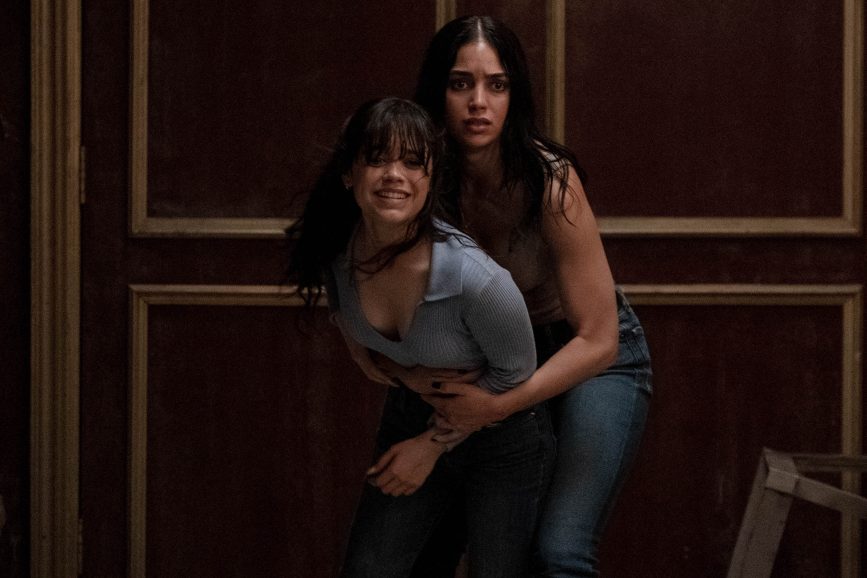
Which shot or scene are you most proud of from Scream VI?
I’m very proud of how the subway sequence turned out – just standing on that set with the light chases moving and the special effects rig shaking the car; even to my eye, it felt like I was standing on a moving subway. It was a huge team effort across all the departments, from Michele and her art department team building the set from scratch, Avery Plewes and her amazing costume design for all of our many background actors, and the special effects team being able to shake and move our subway car, the ADs for organising it all, my camera operators and ACs managing inside that small crowded set, and of course the lighting and grip team for creating an incredible rig that gave me so much control.
One of my favorite shots in the film is of Sam on the balcony in the theater near the end of the movie when she is holding Quinn (Liana Liberato) at gunpoint. It’s a great hero moment for her, and I love the images from the projector side lighting her. It’s not necessarily a complicated shot, but just one of those moments that came together how I had imagined it in prep and even better, thanks to Melissa’s powerful performance.
Are there any lessons you’ll take from this shoot you’ll take onto further instalments of the franchise or your wider work in general?
What I love about this job is that I’m always learning something new – often many things on every project, and this film was no exception. The value of such a strong creative collaboration with the directors and my amazingly talented Montreal-based crew on this film will certainly stay with me going forward.

